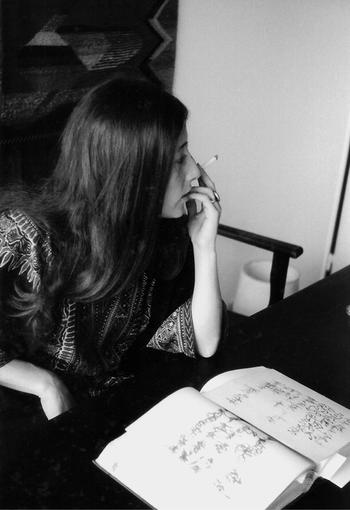Image Credit: Mirtha Dermisache with her first artist’s book Libro Nº 1 (1967), Buenos Aires, 1967. © 2024 Legado Mirtha Dermisache.
Organised by Regine Ehleiter, Research Area 4: "Literary Currencies". Co-initiator and exhibition designer: Anja Lutz (A—Z, Berlin). The exhibition is a collaborative project of the EXC Temporal Communities with A—Z, the Legado Mirtha Dermisache and oxfordberlin. Locations: A—Z, Torstraße 93, 10119 Berlin (main venue) & oxfordberlin, Oxforder Straße 3-11, 13349 Berlin (satellite venue).
Opening of the exhibition "Mirtha Dermisache: To Be Read" at A—Z (Torstr. 93, Berlin-Mitte) with a 'reading' by sound artist Paolo Dellapiana (Torino).
From the late 1960s onwards, the Argentine conceptual artist Mirtha Dermisache (1940–2012) produced numerous publications, containing marks that resemble writing. Although the pages of these works imitate familiar graphic forms, most famously in the case of her newspaper Diario 1: Año 1 (1972, with several later reprints), the signs of which they consist do not convey semantic content. Her work is therefore often contextualised as "asemic writing" – a term coined by Gillo Dorfles in 1974, in response to works by one of Dermisache's contemporaries, the German-Italian artist Irma Blank (1934–2023).
In 1967, Dermisache published her first book, the 500-page Libro n° 1. Other publications followed, always referencing well-known formats of communication – book, text, postcard, letter, bulletin, poem, comic and newspaper – the names of which usually formed part of a work's title, together with its respective number and the year in which it was produced. Rather than presenting only individual pages of the books as samples of the forms with which Dermisache experimented, the exhibition aims to emphasize the mediality and materiality of her publications as works that developed according to a specific sequence and logic, citing familiar layout formats.
While her work has received critical attention in the Americas, France and Belgium in recent years – including, most notably, a large-scale retrospective exhibition at the Museo de Arte Latinoamericano de Buenos Aires (MALBA) in 2017 – it is still absent from art-historical and literary discourses in Germany. Largely produced under conditions of political repression, during the military dictatorship in Argentina, the illegibility of Mirtha Dermisache's publications itself can be read as a resistant gesture, echoing the emptiness of state propaganda and marking her wish to keep 'writing', publishing and spreading her work, despite adverse circumstances.
The exhibition's title "To Be Read" can be understood both as an invitation to attend to Mirtha Dermisache's rich body of work – it is the artist's first solo exhibition in Germany – and as a reflection on the artist's desire to have her work circulated widely. As the artist pointed out on several occasions, her interest was not in producing precious book works, to be collected, fetishized and displayed "like paintings". Although her earliest artist's books are mainly unicums, now held in private collections, she wanted them to exist in larger editions and be circulated as extensively. For her, publications were the "only appropriate space" for her work "to be read." Meaning, she explained, formed "in the hands of the one who picks [a publication] up."
The layout of this exhibition, which is a collaboration between the Cluster of Excellence "Temporal Communities. Doing Literature in a Global Perspective" of the Freie Universität Berlin and A–Z, a space for experimental graphic design in Mitte, run by Anja Lutz, develops these ideas. Following the artist's wishes, it offers visitors the opportunity to browse her books (by means of exhibition copies), and presents a reprint of a publication from the 1970s. Legado Mirtha Dermisache, the artist's estate based in Buenos Aires, and publisher Florent Fajole are supporting the exhibition by donating objects that will later be made available to the wider public at Freie Universität Berlin’s libraries. Apart from the main venue, A–Z, the exhibition expands to a satellite space, the bulletin-board-as-exhibition-space Oxford-Berlin in Wedding, and even beyond, by means of a postcard work by Dermisache, which in due course may travel to unforeseen places.
Time & Location
Jun 06, 2024 | 07:00 PM - 09:00 PM
A—Z (main venue)
Torstraße 93
10119 Berlin
&
oxfordberlin (satellite venue)
Oxforder Straße 3-11
13349 Berlin
Further Information
For more information about her work and a comprehensive biography, please visit: www.mirthadermisache.com.
